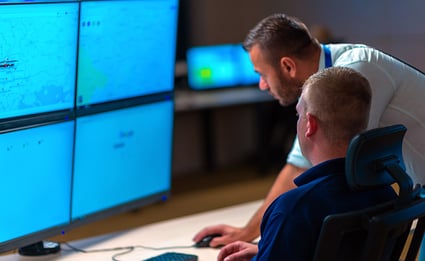Digital Twins: The Supply Chain’s Dynamic Duo
Nancy Sarpolis - March 14, 2023

In today’s supply chain environment, production planners may wish they had a clone to keep up with the ever-quickening pace of disruptions. But those who embrace Industry 4.0 digital technologies may be able to create the next best thing: a “digital twin” of their supply chain operations for rapid, real-world scenario analyses and better decision-making.
A digital twin is essentially a clone of the organization’s supply chain that exists as a virtual entity, mirroring the steps and processes involved from raw material delivery to the customer’s doorstep. The replica can be as small as an individual component within a piece of machinery, or as large as an entire supply chain. Through twins, the physical and digital worlds can interact in such a way as to add connectivity and create new sources of value.
“The digital twins trend is gaining momentum, thanks to rapidly evolving simulation and modeling capabilities, better interoperability and IoT sensors, and more availability of tools and computing infrastructure,” according to Deloitte. “As a result, digital twins’ capabilities are more accessible to organizations large and small, across industries.”
The difference between scenario planning and digital twins
Scenario planning solutions allow planners to change parameters and create different rule models and simulated scenarios. The effects of a change on production or distribution are calculated immediately, allowing the planner to determine the best course of action for each potential scenario.
Digital twins take the concept even further by evaluating multiple scenarios and processes in real-time. Whereas scenario planning solutions collect data from IoT sensors and perfect their predictive capabilities over time, a digital twin of the manufacturing facility uses advanced predictive and prescriptive analytics to not just to map out machinery and production floors into digital space, but to equip those digital reproductions with a constant flow of live operational data. They create a clear link between the data that’s being collected and the application of that data to particular processes in the physical world. The planner is able to test tweaks and make adjustments to optimize the process in real-time, without affecting anything in reality.
Many companies already use digital twins to model production or other processes. But the real value comes from combining them all into a single model that encompasses the entire supply chain.
“A control tower offers insights into operations, while a related digital twin focused on strategy helps with scenario planning and what-if situations,” says E&Y.
Extending the benefits of ERP and MES solutions
Manufacturers that use ERP or MES technologies with integrated planning functionality can extend the benefits of these tools by integrating real-time monitoring solutions with digital twin capabilities. Digital planning twins offer the necessary freedom for optimizing scenarios in cases where complex material structures and multi-stage production processes are needed to meet customers' high expectations of delivery reliability.
Creating a digital twin of a factory floor or entire supply chain allows organizations to use advanced predictive and prescriptive analytics to improve demand sensing, bolster disruption management, create planning alignment between inventory and production workflows, and uncover areas of waste within the value chain. It becomes possible not just to analyze existing processes with an eye towards increasing efficiency, but to implement the suggested optimizations automatically and analyze the results as they occur.
This allows decisions to be made based on sound information, which in turn leads to increased resilience.
A move toward better supply chain visibility
Numerous surveys show visibility across the supply chain is the single most important goal for supply chain managers. Yet only 6% of those surveyed said they had 100% visibility into their own end-to-end network. Implementation of AI-based technologies with digital twin capabilities can bring this goal one step closer to realization. Twin solutions enable rapid scenario analyses that reduce planning effort, lower inventories, and at the same time increase delivery reliability.
There are no two ways about it: Digital twin technologies can help companies pivot faster, whether they are confronting a crisis or seizing a new opportunity.
If you want to learn more get your Guide to Production Planning in Manufacturing Industries
In this Guide you will learn:
-
- How to build resilience
- How to increase efficiency
- How to use integrated APS planning services for production planning
- What must-have features of an APS solution you need
- Which KPI’s you can expect
LATEST POSTS
- Understand Circular Economy in The Manufacturing Industry
- How Can Industry 4.0 IT Integration Be Achieved Smoothly?
- The Significance of Order Sequencing in Discrete Manufacturing
- How to improve your Supply Chain Management: The Power of Control Towers
- Optimizing Human Resource Scheduling in Manufacturing: A Technological Approach



